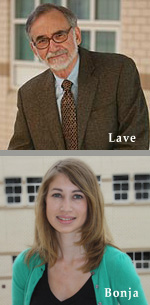Paper prize in memory of Charles Lave rewards creative thinking

Paper prize in memory of Charles Lave rewards creative thinking
- July 23, 2009
- Laura Bonja, economics undergraduate, is inaugural recipient
-----
 Social scientists like asking questions. Rather than accept general assumptions as
fact, they investigate them using models and data to back up their findings. In this
environment, economics professor emeritus Charlie Lave, deceased, was a pro.
Social scientists like asking questions. Rather than accept general assumptions as
fact, they investigate them using models and data to back up their findings. In this
environment, economics professor emeritus Charlie Lave, deceased, was a pro.
When many believed during the late 80s that increasing the speed limit on interstates
would lead to an increase in fatalities, he asked why. He found, contrary to popular
opinion, that speed variance - not an overall increase - is more deadly. During his
more than 30 year research career at UCI, he also found evidence that constructing
rail transit uses more energy than is later saved, and that Californians are less
dependent on the automobile than the rest of the nation.
"Charlie was a really creative thinker," says Frank Cancian, anthropology professor
emeritus and longtime colleague. "He was interested in people who could combine innovative
theory with data that would give you concrete answers."
When he passed away last year, Lave's family, friends and colleagues wanted his memory
and passion for creative, outside-the-box thinking to live on. The Charles A. Lave
Paper Prize for the Most Creative Modeling in Social Sciences was established in his
honor. The endowment provides a $1250 award each year to an undergraduate or graduate
student whose research displays creative use of clear models and data through which
the models may be evaluated.
Laura Bonja, a UC Regents Scholar and senior economics and math double major, is the
inaugural recipient. In her winning paper, she applied economic modeling to study
how shipping costs impact final auction prices for items listed on eBay.
Standard economic theory says that consumers are smart, caring about the total price
they pay for a good. It shouldn't matter whether a seller charges $20 for the good
plus $10 for shipping, or instead charges $30 with free shipping; it's $30 either
way. In her paper, Laura Bonja looked at actual transaction prices on eBay auctions.
She found that the assumption of rationality did not always hold. For some goods,
a seller could get higher total revenue by setting either a free or a relatively high
shipping cost.
"The data shows that buyers will bid more frequently and subsequently drive up the
price on items that list free and high shipping costs as opposed to those with mid-range
shipping costs," she says. The results may seem counterintuitive, but could be important
in explaining purchasing habits - and may be a tip for sellers.
"Some portion of consumers may develop separate pricing criteria for the base and
shipping components of the good or may not fully take into account the price of shipping
when making purchases," she says.
"It's a good idea," says Cancian, and is exactly the kind of innovative, contrarian
finding Lave would have appreciated.
Read more about Charlie Lave online at http://www.economics.uci.edu/?p=139.
View a copy of Bonja's winning paper online at http://www.socsci.uci.edu/wsfdb/docs/bonja2009.pdf.
-----
Would you like to get more involved with the social sciences? Email us at communications@socsci.uci.edu to connect.
Share on:
Related News Items
- Careet RightNotes from a future professor
- Careet RightCan Opportunity Zones ever meet their poverty-fighting promise?
- Careet RightFei Yuan named one of ten global China Times Young Scholar Fellows
- Careet Right'Wired for Words: The Neural Architecture of Language,' an excerpt
- Careet RightEveryone's looking for a partner who has these 3 traits, according to research


